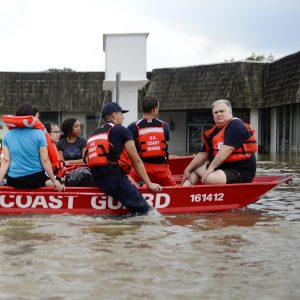Louisiana Floods
On Thursday, August 11, severe rainstorms led to intense flooding in Southern Louisiana while residents fled to safety. Despite a forecast of only eight inches, Zachary, Louisiana saw nearly 2 feet of rainfall in a 48-hour period. Livingston saw about 22 inches within the same period. By Friday, August 12, over 30,000 people had to be evacuated. Over the weekend, the Comite River was 14 feet over its flood stage of 20 feet and the Amite River, with a flood stage of 29 feet, reached 46.2 feet.

In response, 1,700 National Guard soldiers were sent out with boats, helicopters, and high-water vehicles and were joined by about 70 boaters who came to assist with rescue operations. The Coast Guard rescued over 118 people and helped an additional 766 in Baton Rouge. Despite these efforts, eleven people have died from the flooding.
On Tuesday August 16, President Obama granted the emergency declaration from Governor John Bel Edwards to help with response and recovery. By, August 17, 20 parishes had registered with the federal emergency disaster declaration and 60,000 people have registered for FEMA assistance. According to early estimates, roughly 40,000 homes have been destroyed due to flooding and about 8,000 people were in shelters by Monday night. On Tuesday, water slowly started to recede near Baton Rouge, but Governor Edwards said around 34,000 customers were still without electricity. In fact, the Governor and his family were among the residents that had to be evacuated after their basement was inundated with water and the electricity went out.
Many residents in the Baton Rouge area who have been affected by the torrential rain and flooding do not have flood insurance – only “12% of residences are covered by flood insurance.” Jared Serigne of St. Bernard Parish (who helped organize volunteer and rescue efforts) criticized the government for not moving fast enough to clear roads and offer access to boat launch points for volunteers.
In response to the floods Texas climatologist, John Nielsen-Gammon, said that “there’s definitely an increase in heavy rainfall due to climate change.” Strategies for flash floods are constantly tweaked but often have to be refined rapidly because of the difficulty to keep pace with the storm. Julia O’Donoghue from the Times-Picayune stresses that in the long term, standing water that remains in overturned pots, pans, trash cans, etc. will become a breeding ground for mosquitoes that could increase the “health risk for mosquito-related viruses,” specifically West Nile and Zika viruses.
Sources and Further Reading
- Louisiana Flooding: Scope of Deadly Disaster as Told by the Numbers – NBC News
- Edwards Family Evacuates After Louisiana Governor’s Mansion Floods – NOLA.com/The Times-Picayune
- 11 Dead in ‘Historic’ Louisiana Flooding – ABC News
- Louisiana Flooding Victim: First Katrina, Then House Fire, Now This – CNN
- News Wrap: Louisiana Flooding worsens… – PBS News Hour
- As Louisiana Floodwaters Recede, the Scope of Disaster Comes Into View – NY Times
- Louisiana Flooding: West Nile, Not Zika, Poses Bigger Threat – NOLA.com/The Times-Picayune
